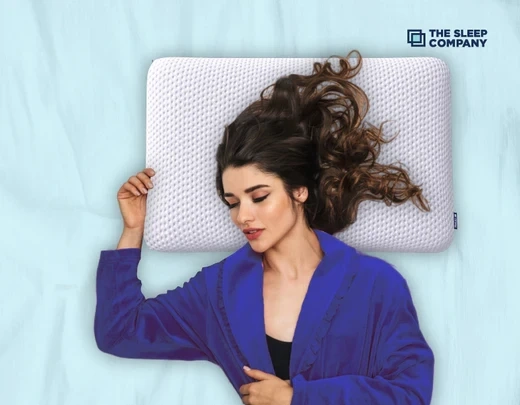Introduction
In the hustle of daily life, we often underestimate the importance of sleep. And when we do think about better sleep, we focus on mattresses, blackout curtains, or bedtime routines — rarely do we consider our pillows. Yet, ergonomic pillows have quietly emerged as sleep health game-changers. Designed not just for comfort but also for spinal alignment and muscle relaxation, these specialized pillows are reshaping how we think about rest and recovery.
In this article, we’ll explore what makes ergonomic pillow different, how they contribute to better sleep health, and why making the switch could be one of the best wellness decisions you ever make.
What Is an Ergonomic Pillow?
An ergonomic pillow is specifically designed to support the natural curvature of your neck and spine. Unlike traditional pillows that offer basic head support, ergonomic pillows are shaped and engineered to promote optimal alignment while reducing pressure points.
They often feature:
- Contoured shapes for head and neck support
- Memory foam or latex materials for adaptive comfort
- Designs tailored to different sleep positions (side, back, stomach)
Why Ergonomic Pillows Matter for Sleep Health
1. Spinal Alignment
Ergonomic pillows maintain the natural “S” curve of your cervical spine. This alignment reduces strain on muscles and ligaments, preventing pain that can disrupt sleep.
2. Reduced Neck and Shoulder Pain
By cradling your neck and relieving pressure on your shoulders, these pillows significantly lower the chance of waking up with stiffness, soreness, or chronic tension headaches.
3. Improved Breathing and Reduced Snoring
Correct head elevation from an ergonomic pillow opens the airways, making it easier to breathe and reducing snoring — especially important for people with mild sleep apnea or allergies.
4. Deep, Uninterrupted Sleep
Less tossing and turning, better neck support, and improved breathing translate into longer periods of deep, restorative sleep.
Who Should Use an Ergonomic Pillow?
While almost anyone can benefit, they’re especially effective for:
- People with chronic neck/back pain
- Office workers with poor posture
- Frequent travelers or those recovering from injuries
- Older adults with reduced joint flexibility
- Sleepers waking up frequently with discomfort
Even if you don’t experience pain now, prevention is key. An ergonomic pillow can help avoid future discomfort caused by years of poor sleeping posture.
Types of Ergonomic Pillows
There is no one-size-fits-all when it comes to ergonomic pillows. Here are the most popular types:
1. Contour Pillows
Shaped with a dip in the center and raised edges, these provide targeted support for the neck and head.
2. Cervical Pillows
Specifically engineered to support the neck’s natural curve and reduce stress on the cervical spine.
3. Wedge Pillows
Designed for those with acid reflux or respiratory issues, these elevate the upper body for better airflow and digestion.
4. Adjustable Fill Pillows
These allow users to add or remove stuffing to get the perfect loft and firmness.
Ergonomic Pillows vs. Traditional Pillows
FeatureErgonomic PillowsTraditional PillowsDesignCurved/contouredFlat/rectangularSupport FocusNeck and spine alignmentGeneral head supportTarget UsersPeople with posture/sleep issuesGeneral sleepersMaterialMemory foam, latex, gelPolyester, cotton, featherDurabilityLonger-lasting, shape-retainingLoses form over time
Choosing the Right Ergonomic Pillow for You
Consider Your Sleeping Position
- Side Sleepers: Look for higher loft and firm support that keeps the head level with the spine.
- Back Sleepers: Choose medium loft and contour designs to cradle the head and neck gently.
- Stomach Sleepers: Soft, low-loft ergonomic pillows reduce neck tilt and pressure.
Match Pillow Height with Shoulder Width
Wider shoulders require higher loft pillows to maintain alignment.
Know the Material
- Memory Foam: Adapts to your shape but can retain heat.
- Latex: Breathable and firm, with excellent durability.
- Cooling Gel: Great for hot sleepers or those in warm climates.
Benefits Backed by Research
Sleep experts and orthopedic specialists recommend ergonomic pillows for their proven benefits in:
- Reducing musculoskeletal discomfort
- Enhancing sleep duration and quality
- Improving posture even outside sleeping hours
- Preventing long-term spinal misalignment
A study published in the Journal of Physical Therapy Science found that ergonomic pillows significantly reduced neck pain and improved sleep quality in individuals with cervical spine issues.
Common Misconceptions About Ergonomic Pillows
Myth 1: They’re too firm and uncomfortable.
Fact: Ergonomic pillows come in various firmness levels. Modern memory foams and hybrids adapt to body heat for soft, personalized support.
Myth 2: Only people with pain need them.
Fact: Preventive care is just as valuable. Ergonomic pillows can help anyone maintain healthy posture and avoid future issues.
Myth 3: They’re expensive and not worth it.
Fact: While pricier than basic pillows, their durability, health benefits, and sleep improvements make them a worthwhile investment.
How to Transition to an Ergonomic Pillow
Switching from a traditional to an ergonomic pillow might take a few nights of adjustment. Here’s how to ease the transition:
- Use your ergonomic pillow for short naps at first.
- Alternate between old and new pillows for a few nights.
- Give it 5–7 days — your body needs time to adapt to better alignment.
Maintenance and Care Tips
To maximize lifespan and hygiene:
- Use a breathable, washable cover
- Air out the pillow regularly
- Clean according to manufacturer’s guidelines (some memory foam pillows are not machine washable)
- Store in a cool, dry place to avoid material breakdown
Final Thoughts: Sleep Smarter, Not Harder
An ergonomic pillow is more than just a comfort item — it’s a health-supporting tool. From spinal alignment and pain reduction to improved sleep quality and mental wellness, the benefits are comprehensive and long-lasting.
If you're tossing and turning or waking up sore and unrested, your pillow might be the problem. But the good news is: it’s an easy fix. Choose an ergonomic pillow that fits your body, sleeping habits, and preferences — and take a big step toward better sleep and better health.


